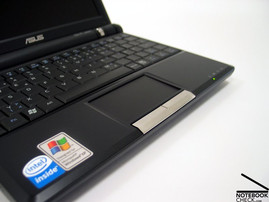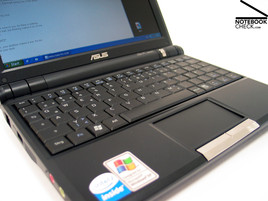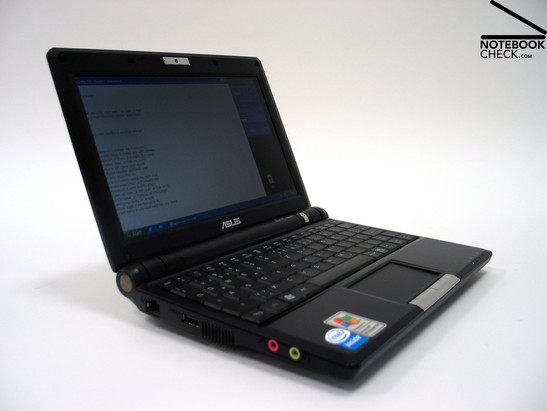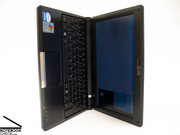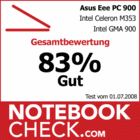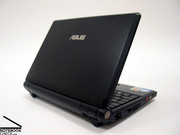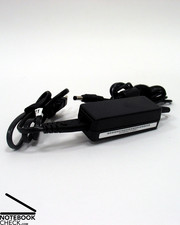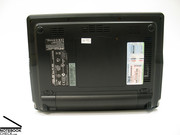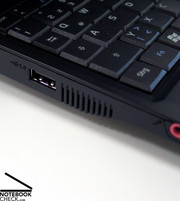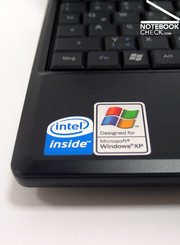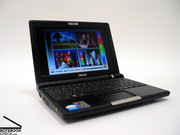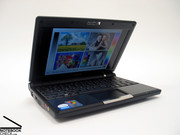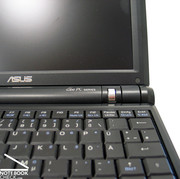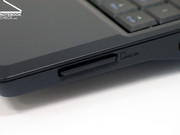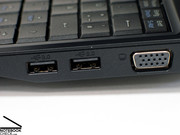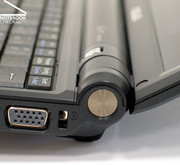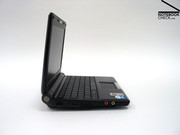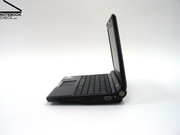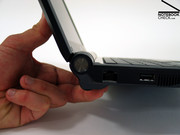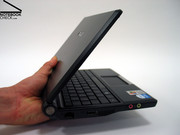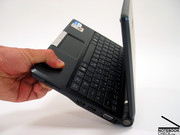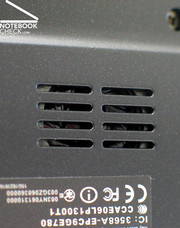Short Review: Asus Eee PC 900 Subnotebook
The Eee is growing up.
Bigger display, more disk space and a full-featured OS sum up to clearly bring the Eee 900 ahead of its predecessor, the Eee 4G. At the same time, the Eee 900 retains a compact and robust chassis with high mobility factor. In the following review you will see how the Asus Eee PC is growing ever closer to becoming a truly classic subnotebook machine.
Housing
Although at first glance the dimensions of the Eee PC 900 housing seem to have hardly changed, the vendor specifications confirm that the case dimensions on the latest model have undergone a slight increase in terms of depth with a somewhat shallower chassis (22.5 x 16.4 x 2.15~3.5 cm for the Eee PC 4G vs. 22.5 x 17.0 x 2.00~2.38 cm for the Eee PC 900). There has also been a change to the overall weight of the machines, with 0.99 kg for the new model compared to 0.92 kg for the 7" 4G model (vendor specifications).
The new display immediately presents itself as the most striking update. The Eee PC 900 sports an 8.9 inch screen, providing both quality full screen video and office-application readiness with a resolution of 1024x600 pixels. Compared to the Eee 4G's 7" panel with a resolution of 800x480 pixels, this could also be the most important update.
In terms of housing design, very little has changed. The striking monitor-hinge design at the back edge, which also houses the battery remains much the same. Although small revisions to the base unit of the compact Eee 900 can be observed, overall there has been very little visibly altered. Noteworthy is that in addition to the model with black housing, there is also a somewhat more elegant white chassis edition (Pearl White) available.
An interesting side note: our colleagues at laptopmag.com were able to differentiate between the White and Black Eee PC versions by the keyboard construction alone. They found the keys on the Black Eee PCs are somewhat smaller that on the white models, with larger gaps between keys.
The new model also performs convincingly in terms of workmanship and casing stability. In a way similar to its 4G sibling, the Eee PC 900 offers a solid, cleanly constructed casing that shows good stability under stress and under everyday handling. This also applies for the two hinges that hold the display in place.
Asus does however continue to skimp on a locking system to secure the display in closed position during transport. Like before, users are warned not to headily transport the device along with other items (such as pens) that could get between the display and the keyboard, potentially damaging both.
Peripheral Connectivity
The number and variety of ports on offer compared to the compact size of the Eee PC 900 is throughly impressive. As with the 7" version, there are three USB ports at hand: two on the right hand side of the chassis and one on the left. The left edge also houses 3.5mm stereo microphone and headphone sockets and there is a LAN port at the back. No modem jack is included.
The Eee 900 also includes in its repertoire a VGA jack on the right hand side which allows the connection of external monitor or projector.
On this side you will also find a Cardreader (SD/MMC) and a Kensington Lock to prevent the sudden unwanted disappearance of this tiny companion.
In regards to communication, the Asus Eee PC 900 offers an ethernet module from Atheros (10/100 Mbps) and a Wireless LAN module (also from Atheros) supporting the 802.11b/g wireless standards.
With the 1.3 megapixel webcam integrated in the display frame, the Eee 900 from Asus is also fit for videotelephony and conferencing. The picture quality in videos is quite acceptable however still photos taken by the camera are noticeably blurry.
Input Devices
A few years ago, it was most commonly the hardware that caused the problems in the computer miniturisation process whereas nowadays the limiting factor has come to lie more often with the ergonomics of the monitor and keyboard. While the display has, as mentioned, clearly increased in size from the previous model, the keyboard has, perhaps for worse, retained the same dimensions.
Being of below average size, the standard character keys just suffice, with practice, to allow touch typing with ten fingers. Nevertheless, expect to make numerous mistakes at the beginning. The right Shift key in particular, which is crammed between the single-row Enter key and the Arrow keys, will take considerable time getting used to.
Frequent use of the Function keys requires extreme finger dexterity. This is because these, like the Escape, Delete and Insert keys, have been further economised in dimension in the quest for size reduction. In addition, the umlaut keys (corresponding to punctuation keys on the US-English keyboard) of the German layout are narrower than the standard keys.
According to the latest reports, after receiving requests for a more user-friendly keyboard in the wake of the Eee 4G, Asus plans to release further new models (Eee PC 904, 905) with bigger keyboards. The technical specifications of the newer models are expected to correspond with the Eee 900 and the Eee 901 with Atom CPU respectively. Due to the size increase, the housing is expected to undergo minor changes.
There have been changes to the touchpad of the machine. The relatively small pad of the older Eee 4G with dimensions of just 45mm x 31mm has been replaced by a new, visibly larger touchpad with multitouch functions. Both touchpad buttons, due to their bigger size, are now also easier to use.
Since the iPhone from Apple surfaced, the term multitouch has been on everybody's lips. The term is essentially understood to mean a pressure sensitive surface which can react to multiple inputs at once. In this way, a whole bunch of useful additional functions can quickly be accessed, such as scrolling through a video with the simultaneous flick of two fingers across the pad, as made famous in videos from Apple. This of course makes a seperate scrolling area on the pad unnecessary.
The multitouch technology is particularly useful when dealing with photos. Photos can be rotated by simply rotating two fingers on the pad, and two fingers moved in opposite directions will zoom in (a reverse of this gesture will zoom out again).
Along with the larger display, multitouch functionality is one of the most convincing improvements of the Eee 900.
Display
With its new 8.9 inch display, the Eee 900 from Asus opens the gates to subnotebooks and new ultra-mobile devices from other manufacturers with displays smaller than 12 inches, or perhaps more appropriately the other way around. The fact is, the 8.9" Panel with a resolution of 1024x600 pixels provides a considerable gain for the user when it comes to viewability and usage possibilities. Where the Eee 4G, at a resolution of 800x480 pixels and an adapted version of Xandros, required constant scrolling around the display to find anything, the new panel provides sufficient visual real estate to run Windows XP, or any other full-featured and dependable operating system.
After loading a number of diffferent websites it soon becomes clear that the 1024 pixels of picture width on offer are generally put to good use. Only the picture height causes an issue, and with just 600 pixels, tends to cut a large part of many websites off. By means of the multitouch touchpad however this is simply and quickly overcome.
| |||||||||||||||||||||||||
Brightness Distribution: 74 %
Contrast: 621:1 (Black: 0.16 cd/m²)
With the new 8.9" monitor of course came hope for a noticably brighter display, in order to improve on the limited to non-existant outdoor visibility on the Asus Eee 4G. It's is clear with the naked eye however that this is sadly not the case, and that no improvements have taken place. Just like the previous model with its 7" display, the maximum settable brightness on the 8.9" panel is 99.3 cd/m². In the corners, this value can reach as low as 73.0 cd/m². This leads to a below average illumination score of 73.5%.
Subjectively, the picture indoors under moderate environmental light conditions can be described as quite sufficiently bright. As soon as the otherwise very mobile device is taken outside however, the image becomes hardly discernable, particularly in sunshine. Not even the in principle passable picture quality of the Eee 900 (apart from its slight graininess and colours that are slightly too pale) and its extremely good maximum contrast of 620:1 can help it. Once again Asus has missed the opportunity to make this otherwise extremely mobile subnotebook able to be used on the road.
The stability of perspective in comparison to other compact subnotebooks was average. In horizontal tests, the display showed an extremely good stability, even with a relatively flat point of view. Results on the vertical perspective tests however were very quickly marred by a shadowing or paling of the picture.
Performance
Despite the hype these days about the Atom CPU from Intel, the Asus Eee 900 in its standard configuration is equipped with an Intel Celeron M CPU and an Intel GMA 900 Graphic Chipset. The Atom CPU, developed especially for miniature devices, will first be deployed in the upcoming models of the Asus Eee PC, such as the Eee 901 model.
The fact that the advertised performance of the Eee PC remains in the background, more than anything makes the Asus Eee PC 900's position in the very lowest price range clear. Although the Eee 900 sells with a sale price of 399 Euro, at 100 Euro more than the shop price of its predecessor, both are comparitively well priced, something still rare for models of their size. This is where the emphasis remains, especially when reports from competitors have constantly multiplied since the Eee PC's introduction: hardly a day goes past in which yet another famous manufacturer introduces a new rival to the Eee. Should the price of the future Eee models rise too high, there would be a lot of competitors which would glady take the bottom price range, driving Asus out of this part of the market.
Be that as it may, the Celeron M 353 CPU from Intel with a clock speed of 900MHz and 512 KB L2-Cache provides performance sufficient to run (if modestly)the fully featured Microsoft Windows XP, in addition to basic applications such as Internet, Mail and Office, while still retaining performance in reserve. Even for these purposes, the Celeron CPU runs with its full 900 MHz and not underclocked, just as in the Asus Eee 4G/701 (630 MHz).
Important above all is the system RAM, which with a total size of 1024 MB (DDR2 PC3200) clearly more abundant than in the 4G model, which should theoretically guarantee the relatively smooth use of Windows XP and Office applications.
In practice however, the user is not spared from waiting times when starting several kinds of programs. Upon opening Star Office for example it takes approximately 15 seconds before the user can begin work. If frequently used programs are manually added to the quick-start list these waiting times indeed decrease, however with just one gigabyte of RAM, care must be taken not to add too many - with Windows XP it is even easier than you think to use it all up.
When its various performance benchmark results are compared with other compact notebooks, the Eee 900 from Asus clearly sits towards the bottom of the pile. For practical use of the notebook for its purposes however these values don't actually mean much. Aside from possible short waiting times, word processing, music and picture playback in addition to internet surfing all perform without issues.
An important part of any notebook's equipment is its internal mass storage. The Eee 900 comes with a total of 12GB in the Windows version in the form of a 4GB and an 8GB SSD card. The Linux version comes with a total of 20GB storage space (4GB + 16GB).
In the HDtune benchmark test, the 4GB SSD achieved a maximum transfer rate of 39.1 MB/sec: a below average result in comparison with conventional hard disks. The SSDs do gain points however in their super fast access times - as little as 0.5 ms for the integrated cards. Storage capacity is also likely to increase in future models and since as memory chips are becoming more affordable, such an upgrade wouldn't necessarily be burdened by a price increase.
| 3DMark 03 Standard | 289 points | |
Help | ||
| Cinebench R10 | |||
| Settings | Value | ||
| Shading 32Bit | 149 Points | ||
| Rendering Single 32Bit | 423 Points | ||
Emissions
System Noise
After initial deathly silence, the system fan starts about five minutes after bootup and then continues in this state for the remaining time the system is running. No performance adapted fan speed setting could be found. Although the noise made by system cooler was very slight, technically measuring under 30 dB(A), because of its high frequency it left a somewhat negative impression. Comparable with the the light buzzing of a mosquito, the noise from the device could pose an issue, particularly for sensitive ears.
Temperature
Even after a long time under load, the recorded case temperatures stay at green levels. Both top and bottom sides warm up fairly uniformly to just under 40°C. The only obtrusive accessory was the small external power brick of the Asus Eee 900, which, reaching up to 50°C, could easily be described as hot.
(+) The maximum temperature on the upper side is 39.9 °C / 104 F, compared to the average of 33.1 °C / 92 F, ranging from 21.6 to 53.2 °C for the class Netbook.
(+) The bottom heats up to a maximum of 39.8 °C / 104 F, compared to the average of 36.6 °C / 98 F
(±) The palmrests and touchpad can get very hot to the touch with a maximum of 37.7 °C / 99.9 F.
(-) The average temperature of the palmrest area of similar devices was 29.3 °C / 84.7 F (-8.4 °C / -15.2 F).
Loudspeakers
On the Asus Eee 4G there was enough space either side of the small 800 pixel wide display for the speakers. In the Eee 900 however, these had to give way for the larger 8.9" panel, being relocated into the base unit, or more specifically to the underside of the base near the front. In the practical test, the speakers achieved a quite passable sound, particularly given the size of the Eee 900's casing. Despite an obvious lack of bass on top of slightly weak sound levels, the integrated speakers are quite comfortably used for background music at moderate sound levels.
Battery Life
Equipped with a 32.56 Wh Li-Ion battery (4400 mAh, 7.4V), the Asus Eee PC 900 provides its hardware with an appropriate power supply. In the BatteryEater Readers test, when set in maximum battery saving mode (WLan deactivated, minimum display brightness, energy saving mode), the machine was found to have a maximum running time of approximately 230 minutes.
Under load, using the BatteryEater Classic test, the Eee 900 achieved a still commendable 120 minutes. Given its battery life, the potential mobility of this pocket companion is further guaranteed.
| Off / Standby | |
| Idle | |
| Load |
|
Verdict
As in its motto, "Easier to Learn, Easier to Work, Easier to Play", the three Eees in the Eee PC's latest version, the Eee 900, fitted with a couple of new gadgets, make a lot of things in life a whole lot easier. One of these features, perhaps more important than any other, is the larger display with a diagonal of 8.9 inches and a resolution of 1024x600 pixels.
With regard to user friendliness, the possibility of using Windows XP really is a step in the right direction, particularly when it has come hand in hand with improved performance. For the time being, as in the 4G/701, the Eee PC 900 is fitted with a Celeron CPU from Intel, which is run at full speed. Supported by a gigabyte of RAM and a total of 12 gigabytes of storage space in the form of two SSDs, the Eee 900 offers enough performance to meet the needs of simple office applications, when the user has the patience to spend a bit of time waiting now and then.
The keyboard offers, as in previous models, the absolute minimum for a full-featured input device. The compact size of the case makes providing anything more than this difficult. We were very pleasantly surprised by the new multitouch touchpad, which provides the Eee 900 with a whole bunch of practical new functions.
However positive the development in the display panel may be, the dirty side of the medal remains that the brightness of the Eee PC 900's monitor is far too meagre for sensible outdoors use. The compact companion's biggest potential still lies in its mobility, which is unfortunately but clearly limited by this at best moderate display brightness. When all is said and done, not even the very reasonable battery life of up to four hours can change much about that.
We'd like to thank the company MediaMarkt Wels, who kindly provided us with the test machine for this review. The device can also be ordered from their website.


 Deutsch
Deutsch English
English Español
Español Français
Français Italiano
Italiano Nederlands
Nederlands Polski
Polski Português
Português Русский
Русский Türkçe
Türkçe Svenska
Svenska Chinese
Chinese Magyar
Magyar




